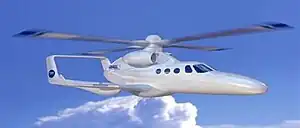| Heliplane | |
|---|---|
 | |
| Image of baseline GBA-DARPA Heliplane concept, showing its free-spinning rotor, which is fitted with integral tipjets, fed with bypass air from two Williams gas-turbine propulsion engines | |
| Role | Experimental helicopter |
| National origin | United States |
| Manufacturer | Groen Brothers Aviation |
| Status | Canceled |
The GBA-DARPA Heliplane was a proof-of-concept, long-range, VTOL aircraft intended to cruise at twice the speed of conventional helicopters.[1] It was funded by the Defense Advanced Research Projects Agency (DARPA) and designed by Groen Brothers Aviation (GBA), which has since been re-branded as Skyworks Global.
Development
DARPA's objective was to achieve performance with a rotary-wing aircraft comparable to that of a fixed-wing plane. The concept combined technical aspects of a gyroplane, which GBA had been working on since the late 1980s,[2] with a fixed-wing business jet.
The work was part of a potential multi-year, US$40-million, four-phase program. GBA, along with Georgia Tech, Adams Aircraft Industries, and Williams International, worked on Phase 1 of that program, a 15-month effort funded at $6.4 million. Phase 1B of the program was managed by Georgia Tech, using GBA as a subcontractor. Phase 2 development was to include a "subscale wind tunnel demonstration in the high-speed, high-altitude wind tunnel at NASA Langley and the building of a full-scale tipjet nozzle. Phase 2 [was] anticipated to be a substantially bigger undertaking (valued at $24-28 million)."[1]
Due to issues with noise generated by the tipjets, the program was terminated by DARPA in 2008.[3]
In 2012, Groen Brothers Aviation was acquired by investor Steve Stevanovich as it was collapsing and nearly bankrupt, and was renamed Skyworks Global in 2017.[4] In July 2019, Skyworks partnered with Northrop Grumman-owned Scaled Composites to develop a VertiJet gyrocopter prototype, aiming for a 348kn (644 km/h) cruise and a 1,000nmi (1,850 km) range; it was projected that the aircraft would fly within 18–24 months.[4] Intended to fulfil the US Marine Corps’ armed escort requirements disclosed in April 2019 for a rotorcraft that could match the performance of the Bell Boeing V-22 Osprey; it was also projected that a commercial gyrocopter carrying four passengers could be built for less than $10 million.[4]
See also
References
- 1 2 Pengeley, R. (June 2009). "Gyrodyne Testing Resumes in the US". Jane's International Defence Review. p. 13.
- ↑ "Best Inventions of 2001: Gyroplane". Time. 19 November 2001. Archived from the original on July 26, 2010.
- ↑ "Darpa Takes Another Shot At High-Speed VTOL". Aerospace Daily & Defense Report. Aviation Week. 26 February 2013. Retrieved 31 July 2018.
- 1 2 3 Garrett Reim (16 July 2019). "Skyworks gyrocopter returns from the brink". Flightglobal.